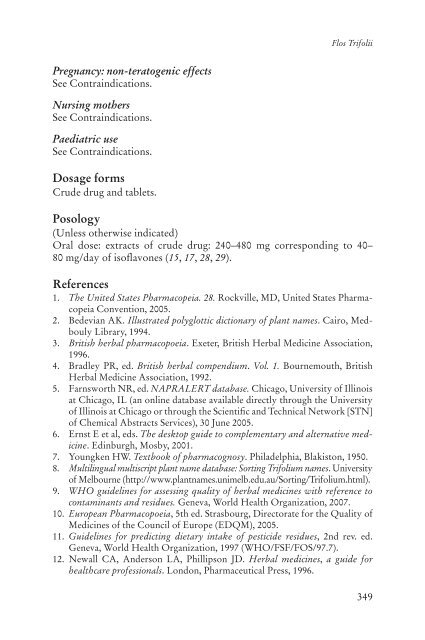WHO monographs on selected medicinal plants - travolekar.ru
WHO monographs on selected medicinal plants - travolekar.ru WHO monographs on selected medicinal plants - travolekar.ru
Flos Trifolii Pregnancy: non-teratogenic effects See Contraindications. Nursing mothers See Contraindications. Paediatric use See Contraindications. Dosage forms Crude drug and tablets. Posology (Unless otherwise indicated) Oral dose: extracts of crude drug: 240–480 mg corresponding to 40– 80 mg/day of isoflavones (15, 17, 28, 29). References 1. The United States Pharmacopeia. 28. Rockville, MD, United States Pharmacopeia Convention, 2005. 2. Bedevian AK. Illustrated polyglottic dictionary of plant names. Cairo, Medbouly Library, 1994. 3. British herbal pharmacopoeia. Exeter, British Herbal Medicine Association, 1996. 4. Bradley PR, ed. British herbal compendium. Vol. 1. Bournemouth, British Herbal Medicine Association, 1992. 5. Farnsworth NR, ed. NAPRALERT database. Chicago, University of Illinois at Chicago, IL (an online database available directly through the University of Illinois at Chicago or through the Scientific and Technical Network [STN] of Chemical Abstracts Services), 30 June 2005. 6. Ernst E et al, eds. The desktop guide to complementary and alternative medicine. Edinburgh, Mosby, 2001. 7. Youngken HW. Textbook of pharmacognosy. Philadelphia, Blakiston, 1950. 8. Multilingual multiscript plant name database: Sorting Trifolium names. University of Melbourne (http://www.plantnames.unimelb.edu.au/Sorting/Trifolium.html). 9.
- Page 306 and 307: WHO monogr
- Page 308 and 309: WHO monogr
- Page 310 and 311: WHO monogr
- Page 312 and 313: WHO monogr
- Page 314 and 315: WHO monogr
- Page 316 and 317: WHO monogr
- Page 318 and 319: WHO monogr
- Page 320 and 321: WHO monogr
- Page 322 and 323: WHO monogr
- Page 324 and 325: WHO monogr
- Page 326 and 327: WHO monogr
- Page 328 and 329: WHO monogr
- Page 330 and 331: WHO monogr
- Page 332 and 333: WHO monogr
- Page 334 and 335: WHO monogr
- Page 336 and 337: WHO monogr
- Page 338 and 339: WHO monogr
- Page 340 and 341: WHO monogr
- Page 342 and 343: WHO monogr
- Page 344 and 345: WHO monogr
- Page 346 and 347: WHO monogr
- Page 348 and 349: WHO monogr
- Page 350 and 351: WHO monogr
- Page 352 and 353: WHO monogr
- Page 354 and 355: WHO monogr
- Page 358 and 359: WHO monogr
- Page 360 and 361: WHO monogr
- Page 362 and 363: WHO monogr
- Page 364 and 365: WHO monogr
- Page 366 and 367: WHO monogr
- Page 368 and 369: WHO monogr
- Page 370 and 371: WHO monogr
- Page 372 and 373: Cortex Viburni Prunifolii Definitio
- Page 374 and 375: WHO monogr
- Page 376 and 377: WHO monogr
- Page 378 and 379: WHO monogr
- Page 380 and 381: WHO monogr
- Page 382 and 383: WHO monogr
- Page 384 and 385: WHO monogr
- Page 386 and 387: WHO monogr
- Page 388 and 389: WHO monogr
- Page 390 and 391: WHO monogr
- Page 392 and 393: WHO monogr
- Page 394 and 395: WHO monogr
- Page 396 and 397: WHO monogr
- Page 398 and 399: WHO monogr
- Page 400 and 401: Annex 1 Participants of the Fourth
- Page 402 and 403: WHO monogr
- Page 404 and 405: WHO monogr
Flos Trifolii<br />
Pregnancy: n<strong>on</strong>-teratogenic effects<br />
See C<strong>on</strong>traindicati<strong>on</strong>s.<br />
Nursing mothers<br />
See C<strong>on</strong>traindicati<strong>on</strong>s.<br />
Paediatric use<br />
See C<strong>on</strong>traindicati<strong>on</strong>s.<br />
Dosage forms<br />
C<strong>ru</strong>de d<strong>ru</strong>g and tablets.<br />
Posology<br />
(Unless otherwise indicated)<br />
Oral dose: extracts of c<strong>ru</strong>de d<strong>ru</strong>g: 240–480 mg corresp<strong>on</strong>ding to 40–<br />
80 mg/day of isoflav<strong>on</strong>es (15, 17, 28, 29).<br />
References<br />
1. The United States Pharmacopeia. 28. Rockville, MD, United States Pharmacopeia<br />
C<strong>on</strong>venti<strong>on</strong>, 2005.<br />
2. Bedevian AK. Illustrated polyglottic dicti<strong>on</strong>ary of plant names. Cairo, Medbouly<br />
Library, 1994.<br />
3. British herbal pharmacopoeia. Exeter, British Herbal Medicine Associati<strong>on</strong>,<br />
1996.<br />
4. Bradley PR, ed. British herbal compendium. Vol. 1. Bournemouth, British<br />
Herbal Medicine Associati<strong>on</strong>, 1992.<br />
5. Farnsworth NR, ed. NAPRALERT database. Chicago, University of Illinois<br />
at Chicago, IL (an <strong>on</strong>line database available directly through the University<br />
of Illinois at Chicago or through the Scientific and Technical Network [STN]<br />
of Chemical Abstracts Services), 30 June 2005.<br />
6. Ernst E et al, eds. The desktop guide to complementary and alternative medicine.<br />
Edinburgh, Mosby, 2001.<br />
7. Youngken HW. Textbook of pharmacognosy. Philadelphia, Blakist<strong>on</strong>, 1950.<br />
8. Multilingual multiscript plant name database: Sorting Trifolium names. University<br />
of Melbourne (http://www.plantnames.unimelb.edu.au/Sorting/Trifolium.html).<br />
9. <str<strong>on</strong>g>WHO</str<strong>on</strong>g> guidelines for assessing quality of herbal medicines with reference to<br />
c<strong>on</strong>taminants and residues. Geneva, World Health Organizati<strong>on</strong>, 2007.<br />
10. European Pharmacopoeia, 5th ed. Strasbourg, Directorate for the Quality of<br />
Medicines of the Council of Europe (EDQM), 2005.<br />
11. Guidelines for predicting dietary intake of pesticide residues, 2nd rev. ed.<br />
Geneva, World Health Organizati<strong>on</strong>, 1997 (<str<strong>on</strong>g>WHO</str<strong>on</strong>g>/FSF/FOS/97.7).<br />
12. Newall CA, Anders<strong>on</strong> LA, Phillips<strong>on</strong> JD. Herbal medicines, a guide for<br />
healthcare professi<strong>on</strong>als. L<strong>on</strong>d<strong>on</strong>, Pharmaceutical Press, 1996.<br />
349



